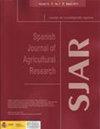Prospective study of the technology for evaluating and measuring in-row seed spacing for precision planting: A review
IF 0.8
4区 农林科学
Q3 AGRICULTURE, MULTIDISCIPLINARY
引用次数: 1
Abstract
Corn is the most cultivated and consumed cereal in the world. The overall objective of this review was to study the methodologies to measure and evaluate the in-row seed spacing for precision planting as well as to determine the technological alternatives that would allow obtaining information about seed mapping for corn crop planting in precision agriculture applications. As a conceptual synthesis about the electronic measurement system, there are two strategies for determining in-row seed spacing in the precision planting. Indirect methods correspond to the measurement before the seeds reach the furrow, while direct methods correspond to the measurement with the seeds placed in the furrow. The indirect measurement strategy is the most widely used in research publications and commercial planter monitors. Within this method, the seed spacing measurement systems use optical or radio wave type seed sensors. Corn seed counting accuracy through electronic measurement systems with optical-type seed sensor is at least 96%. The microwave seed sensor is used commercially by a few companies whose technologies are patented. The direct measurement strategy is under development and requires further research. The main limitation of these technologies is the seed detection in the furrow, which limits the planter travel speed and the equipment cost. The conceptual proposal for the term ‘seed mapping’ is to provide integrated and geo-referenced information on in-row seed spacing and depth for precision planting.精密种植行间距评价与测量技术的前瞻性研究
玉米是世界上种植和消费最多的谷物。本综述的总体目标是研究测量和评估精确种植的行内种子间距的方法,并确定技术替代方案,以获得有关精确农业应用中玉米作物种植的种子测绘信息。作为电子测量系统的概念综合,在精确种植中有两种确定行内种子间距的策略。间接方法对应于种子到达犁沟之前的测量,而直接方法对应于将种子放入犁沟中的测量。间接测量策略在研究出版物和商业播种机监控器中使用最为广泛。在该方法中,种子间距测量系统使用光学或无线电波类型的种子传感器。通过带有光学型种子传感器的电子测量系统,玉米种子计数的准确率至少为96%。微波种子传感器被一些技术获得专利的公司商业化使用。直接测量策略正在制定中,需要进一步研究。这些技术的主要局限性在于犁沟中的种子检测,这限制了播种机的行进速度和设备成本。“种子测绘”一词的概念建议是提供关于行内种子间距和深度的综合和地理参考信息,用于精确种植。
本文章由计算机程序翻译,如有差异,请以英文原文为准。
求助全文
约1分钟内获得全文
求助全文
来源期刊

Spanish Journal of Agricultural Research
农林科学-农业综合
CiteScore
2.00
自引率
0.00%
发文量
60
审稿时长
6 months
期刊介绍:
The Spanish Journal of Agricultural Research (SJAR) is a quarterly international journal that accepts research articles, reviews and short communications of content related to agriculture. Research articles and short communications must report original work not previously published in any language and not under consideration for publication elsewhere.
The main aim of SJAR is to publish papers that report research findings on the following topics: agricultural economics; agricultural engineering; agricultural environment and ecology; animal breeding, genetics and reproduction; animal health and welfare; animal production; plant breeding, genetics and genetic resources; plant physiology; plant production (field and horticultural crops); plant protection; soil science; and water management.
 求助内容:
求助内容: 应助结果提醒方式:
应助结果提醒方式:


